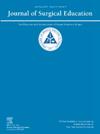Promoting Longevity in Surgical Careers: A Narrative Review and Fitness Program to Reduce Occupational Pain
IF 2.6
3区 医学
Q1 EDUCATION, SCIENTIFIC DISCIPLINES
引用次数: 0
Abstract
Importance
Many surgeons experience work-related musculoskeletal disorders (MSD) throughout their career. Incorporating evidence-based strategies to prevent and manage MSDs would benefit both trainees and those in practice. The present narrative review seeks to evaluate the effectiveness of current strategies to manage and prevent musculoskeletal (MSK) occupational pain among surgeons and trainees.
Observations
Eleven studies were identified. Included studies covered 3 broad interventions: ergonomics (n = 5), intraoperative breaks/pauses (n = 7), and physical fitness (n = 1). Intraoperative breaks demonstrated improved pain, fatigue, stress, and a decrease in intraoperative errors without increasing overall surgical time. Residents that were specifically instructed in ergonomics exhibited better posture and decreased musculoskeletal (MSK) symptoms and recommended incorporating this information into their curriculum. In a program combining ergonomics, microbreaks, and stretching, 85% of residents experienced reduced discomfort, and 93% felt this training would help them “perform better in the operating room”. Overall, the surgical physical fitness programs reduced surgery/occupational-related pain and increased performance measures in the OR. The study participants also found the interventions valuable and were able to use learned principles in practice.
Conclusions and Relevance
The existing body of literature supports the positive impact of fitness programs in preventing and managing occupational-related pain. We propose the implementation of a comprehensive program that integrates education, intraoperative breaks, ergonomic adjustment, and physical fitness, with initiation during the first year of surgical residency. To facilitate practical integration, we propose a pilot program that may be integrated into the regular surgical work week, encompassing recommendations from the reviewed studies. Future research is recommended to explore aspects such as program effectiveness, feasibility, mental health impacts, and gender-specific differences.
促进外科职业生涯的寿命:减轻职业疼痛的叙述回顾和健身计划
许多外科医生在其职业生涯中都经历过与工作相关的肌肉骨骼疾病(MSD)。将基于证据的战略纳入预防和管理MSDs将使学员和实践人员都受益。目前的叙述性审查旨在评估当前策略的有效性,以管理和预防肌肉骨骼(MSK)职业疼痛的外科医生和学员。观察发现了6项研究。纳入的研究涵盖3个广泛的干预措施:人体工程学(n = 5)、术中休息/暂停(n = 7)和身体健康(n = 1)。术中断裂表现出疼痛、疲劳、压力的改善,术中错误的减少,而不增加总手术时间。接受人体工程学专门指导的住院医生表现出更好的姿势和减少的肌肉骨骼(MSK)症状,并建议将这些信息纳入他们的课程。在一个结合人体工程学、微休息和拉伸的项目中,85%的住院医生感到不适减轻了,93%的人认为这种训练可以帮助他们“在手术室里表现得更好”。总的来说,手术身体健康计划减少了手术/职业相关的疼痛,提高了手术室的表现。研究参与者还发现干预措施是有价值的,并且能够在实践中使用学到的原则。结论和相关性现有文献支持健身计划在预防和管理职业相关疼痛方面的积极影响。我们建议实施一项综合计划,包括教育、术中休息、人体工程学调整和身体健康,并在外科住院医师的第一年开始。为了促进实际的整合,我们提出了一个试点计划,该计划可以整合到常规的外科工作周中,包括从所回顾的研究中得到的建议。未来的研究建议探索项目的有效性、可行性、心理健康影响和性别差异等方面。
本文章由计算机程序翻译,如有差异,请以英文原文为准。
求助全文
约1分钟内获得全文
求助全文
来源期刊

Journal of Surgical Education
EDUCATION, SCIENTIFIC DISCIPLINES-SURGERY
CiteScore
5.60
自引率
10.30%
发文量
261
审稿时长
48 days
期刊介绍:
The Journal of Surgical Education (JSE) is dedicated to advancing the field of surgical education through original research. The journal publishes research articles in all surgical disciplines on topics relative to the education of surgical students, residents, and fellows, as well as practicing surgeons. Our readers look to JSE for timely, innovative research findings from the international surgical education community. As the official journal of the Association of Program Directors in Surgery (APDS), JSE publishes the proceedings of the annual APDS meeting held during Surgery Education Week.
 求助内容:
求助内容: 应助结果提醒方式:
应助结果提醒方式:


